Last updated: March 15, 2019
Article
Bat Projects in Parks: Devils Tower National Monument
Summary
WNS and Bat Projects: Education, Monitoring, Roost Identification
PI: Rene Ohms
Devils Tower (DETO) used the allocated funding to educate climbers and the general public on the threat of WNS and the importance of protecting bats and their habitat, through special events and outreach materials. The park hosted a Bat Festival on July 16, with partner support from USFWS, USFS, BLM, other parks, Wyoming Natural Diversity Database, and Devils Tower Natural History Association. The event reached several hundred visitors, including nearly 200 children, and included booths on WNS, decontamination, bats & climbers, bat ecology, bat detectors, tracking and telemetry, bat houses, and bat exclusion techniques. Climbing biological science technicians attended Black Hills Climbers Coalition meetings, to educate local climbers on the importance of bats, the threat of WNS, and the need to report bat sightings. They also developed a bat observation data sheet, which climbers can use to report sightings. On September 24, DETO will host a National Public Lands Day event to educate the public on the search for bats in the Tower, which will be presented by the climbing biotechs. Afterward, the public will help to conduct emergence counts around the base of the Tower, and will use handheld detectors to listen to echolocation calls.
DETO also used funds to continue acoustic monitoring, including winter/spring work, which showed that there are hibernacula near the Devils Tower formation and/or the talus boulder field below the Tower. Microphones for the park's Wildlife Acoustics SM3BAT units were upgraded this year, resulting in clearer recordings. DETO's term wildlife biological science technician wrote a monitoring protocol, set up and troubleshooted all equipment, and analyzed all acoustic data from 2015 to summer 2016. She has correlated the data with temperature, hours after sunset, and habitat type, and is working on a final report. This term employee also attended the WNS conference in Denver, Colorado in June 2016. Allocated funds were also used to search for bats in the boulder field and Tower formation. This work was conducted by seasonal climbing biological science technicians. Bats were found roosting in crevices on the Tower, and evening emergence counts showed bats emerging from several locations in and around the Tower. Endoscopic cameras were purchased and used to capture images and video of bats in cracks on Devils Tower, including one that was over 1 meter deep. A 12-week SCA bat monitoring intern was hired. The intern, a current student and environmental studies major, gained real world experience in wildlife monitoring and management, assisted with mist netting efforts, tracked bats with telemetry techniques, recorded habitat data, helped to plan the Bat Festival, and staffed an educational booth at the event.
DETO provided guidance and materials to GLCA to assist them with planning their first Bat Festival, and also provided Sonobat acoustic analysis training to a Black Hills National Forest wildlife biologist. IMR hydrologist Sharla Stevenson made two site visits to DETO to evaluate the health of springs, which provide important water sources and habitat for bats. Two springs, including one where many bats were captured in 2015 and 2016, have altered flow characteristics from historic development. As a result of her site visits, DETO is pursuing degraded wetlands funding for a project to restore flow and improve habitat. Note that mist-netting and radio transmitter work was accomplished through an RM-CESU agreement, which was FLREA-funded. WNS funds were used for biological science technicians and an SCA intern who assisted with mist-netting, conducted the telemetry work, and recorded roost and habitat data.
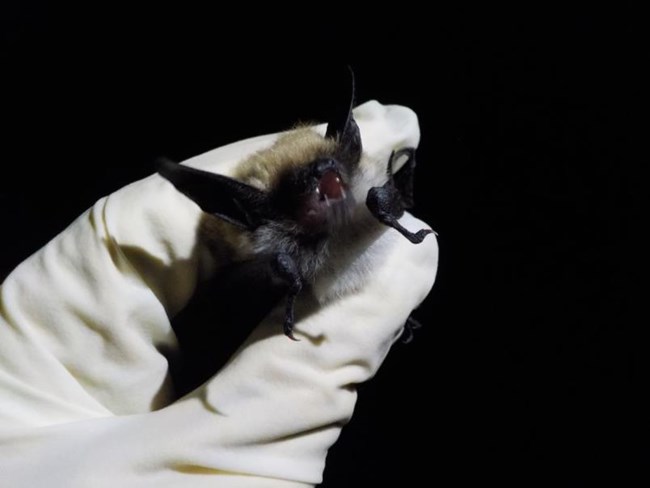
NPS Photo
Bats at Devils Tower
- Devils Tower has 11 species of bats. These are predominately western species, with the exception of the eastern red bat and the threatened northern long-eared bat.
- There are no known cave resources at Devils Tower. Bats were long assumed to be summer residents only.
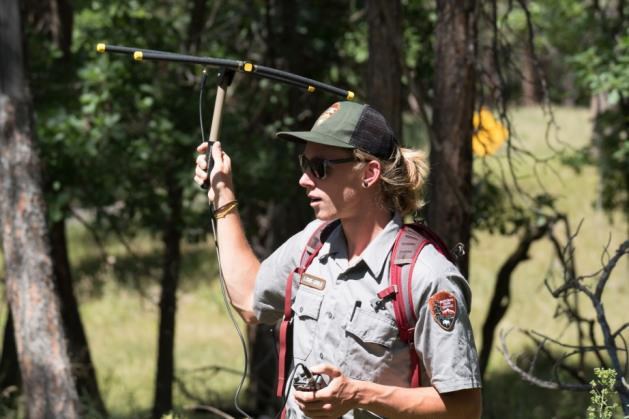
NPS Photo
Mist Netting and Telemetry
- In 2015 and 2016, DETO worked with the University of Wyoming to capture and tag northern long-eared bats. The bats were tracked to roost trees.
- Only male northern long-eared bats have been captured and tracked so far. No maternity roost trees have yet been identified.
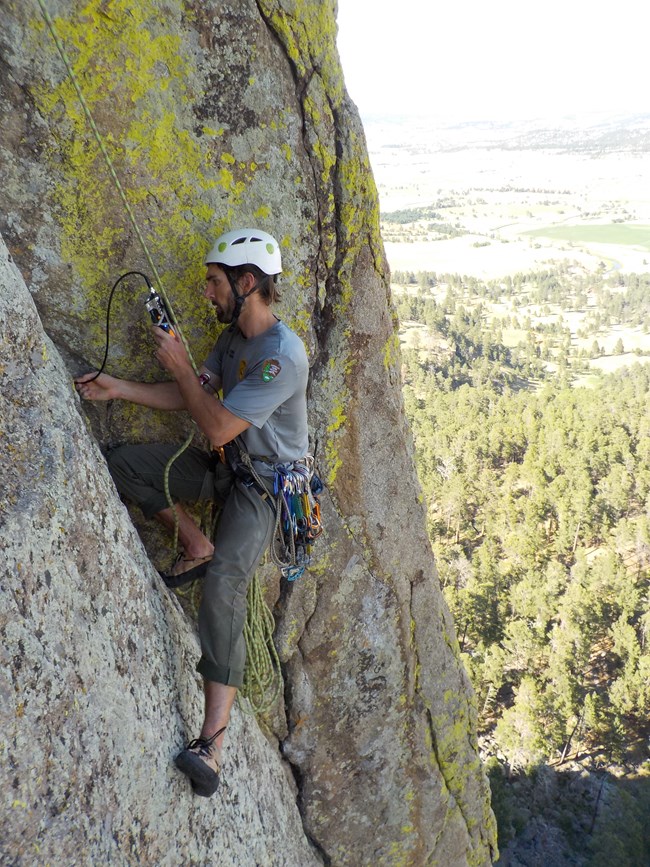
NPS Photo
Climbing for Bats
Devils Tower's cracks and extensive talus field could provide habitat for many bat species.
In 2016, DETO hired two climbing biological science technicians, who looked for bats in the vertical environment.
- The climbing bio-techs used evening emergence observations to prioritize their search.
- On rappel, the climbers searched priority cracks with an endoscopic camera.
Climber Education and Citizen Science
- Climbers were encouraged to report bat sightings on the Tower.
- DETO staff attended Black Hills Climbers Coalition meetings & an Access Fund Resource Stewardship training, to educate climbers on the importance of bats.
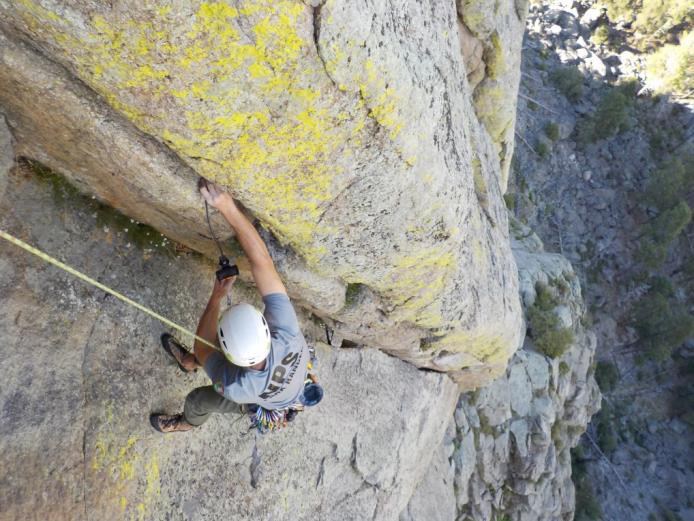
NPS Photo
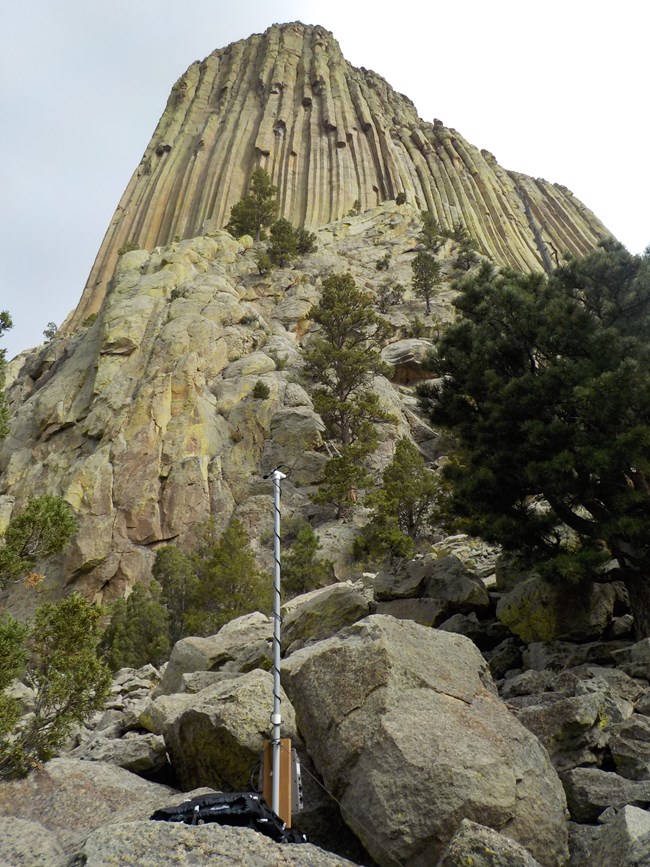
NPS Photo
Acoustic Monitoring
- Acoustic data collected in 2014 indicted that bats were present at DETO through late October.
- A 2015-2016 winter acoustic survey sough to determine if bats were indeed using DETO in the winter.
- In an area bereft of caves, mines, and other "traditional" hibernacula, could bats be using Devils Tower in the winter? The results?! Fascinating!
- Bats were found roosting in crevices on the Tower, and evening emergence counts showed bats emerging from several locations in and around the Tower.
Future Plans
- Environmental and bat swabbing
- Early spring emergence captures and telemetry
- Continue monitoring for bats on/near Tower
- Boulder field mist netting
- Acoustic monitoring in and near boulder fields
- Utilize temperature and humidity loggers with acoustics and in potential roost crevices
- Additional climber education/WNS screening






